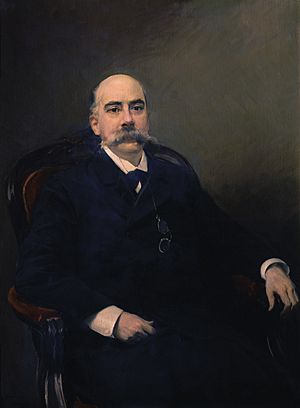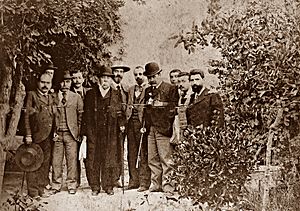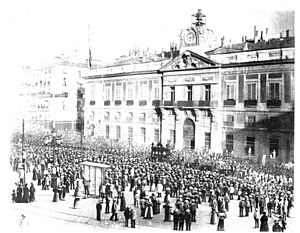Emilio Castelar facts for kids
Quick facts for kids
The Most Excellent
Emilio Castelar
|
|
|---|---|

Castelar, by Joaquín Sorolla.
|
|
| President of the Executive Power | |
| In office 7 September 1873 – 3 January 1874 |
|
| Preceded by | Nicolás Salmerón |
| Succeeded by | Francisco Serrano |
| Seat D of the Real Academia Española | |
| In office 25 April 1880 – 25 May 1899 |
|
| Preceded by | Pedro Felipe Monlau |
| Succeeded by | Jacinto Octavio Picón |
| Personal details | |
| Born |
Emilio Castelar y Ripoll
7 September 1832 Cádiz, Spain |
| Died | 25 May 1899 (aged 66) San Pedro del Pinatar, Spain |
| Resting place | Saint Isidore Cemetery |
| Signature | |
Emilio Castelar y Ripoll (born September 7, 1832 – died May 25, 1899) was an important Spanish politician. He was a republican, meaning he believed Spain should be a republic, not a monarchy (ruled by a king or queen). He even became the president of the First Spanish Republic.
Castelar was born in Cádiz, a city in Spain. He was known for being a great speaker and a talented writer. In 1873, during a time of war called the Third Carlist War, he was chosen to be the Head of State. The Parliament gave him special powers, so he ruled by making laws himself. He left office the next year after a military takeover led by General Pavía.
He wrote many books about politics, including a history of the Republican Movement in Europe.
Contents
Early Life and Education
Emilio Castelar lost his father when he was seven years old. His father had been involved in political protests and had lived in England for some years. Emilio went to grammar school in Sax.
In 1848, he started studying law in Madrid. But he soon decided to focus on philosophy and literature. He earned a special degree called a doctorate in 1853. During a Spanish revolution in 1854, Castelar was a student who supported the republic. Young liberals and democrats held a big meeting in Madrid. Castelar gave his first speech there, which made him a well-known political figure during the reign of Queen Isabella II.
Starting a Political Career
From that moment on, Castelar became very active in politics. He wrote for radical newspapers and pursued literary and historical interests. He was involved in an uprising in June 1866, which was put down by the military. Castelar was sentenced to death, so he had to hide and then escape to France.
He lived in France for two years. Then, the successful Revolution of 1868 allowed him to return to Spain. He became a representative in the Cortes (Spanish Parliament) for the first time, representing Zaragoza. He also started teaching history again at the Complutense University of Madrid.
Castelar became famous for his speeches in 1869. He led the group of republicans who wanted Spain to become a federal republic. This caused problems for leaders like Serrano and Prim, who wanted to bring back the monarchy. Castelar strongly criticized the different plans to put a new king on the throne, including Amadeus of Savoy. He played a part in the downfall of Amadeus's short-lived monarchy.
Leading the First Spanish Republic
When King Amadeus gave up his throne, the Federal Republic was declared. Even though most members of Parliament were monarchists, they were persuaded by the republican minority, including Castelar, to support democracy. The Federal Republic lasted a short time, from February 11, 1873, to January 3, 1874. This was the peak of Castelar's career. Many people praised how he acted during these eleven months. However, some of his republican friends disagreed with his choices.
Before the 1868 Revolution, Castelar had started to disagree with some extreme republicans. He hated violence and did not like mob rule or military takeovers. He wanted a parliamentary republic, similar to the United States, with some ideas from the Swiss constitution. This would respect the different regions of Spain. He wanted a president and Parliament chosen by the people, ruling fairly and respecting traditions and national unity.
First Federal Republic Government
At first, Castelar worked well with the other republican members of the first government of the Federal Republic. He became the minister for foreign affairs. There were difficulties between the new government and the Parliament's president, Señor Martos. Marshal Serrano and many military leaders wanted to overthrow the republic. However, the republican ministers were able to gain control.
The Parliament was dissolved, and new elections were held. The new Parliament met in the summer of 1873. It soon became clear that they were not able to govern effectively. The president, Figueras, even left his post and fled the country. Other leaders, Pi y Margall and Salmeron, tried to govern but struggled. Salmeron had to ask some generals to command the armies in the south and north of Spain. These generals helped put down some local uprisings.
However, the Parliament continued to cause problems. President Salmeron resigned. The Parliament then chose Castelar to be the chief of the executive, even though his supporters were a minority. They also decided to close Parliament until January 2, 1874. This was a major turning point, as it eventually led to the return of the monarchy.
Castelar as President, 1873
When Castelar became the leader of Spain in September 1873, he immediately focused on rebuilding the army. The army had shrunk to only about 70,000 soldiers. This was not enough to fight against the 60,000 Carlists (supporters of a different royal family) and the remaining rebels in places like Alcoy and Cartagena. To fix this, Castelar called for over 100,000 new soldiers, who joined the army quickly.
He chose his generals based on their skills, not their politics. He sent General Moriones to the Basque provinces and Navarre with 20,000 men. He sent General Martinez Campos to Catalonia and General Lopez Dominguez to blockade Cartagena, where the navy had joined the revolt.
Castelar and the Church
Castelar also worked to improve relations with the Church. He re-established contact with the Vatican and convinced Pope Pius IX to approve his choices for new bishops. He stopped all persecution of the Church and religious groups and made sure Church property was respected. He also tried to fix the country's finances to pay for the three ongoing civil wars: the Carlist war, the cantonal (local) revolts, and the war in Cuba.
The Cuban rebels caused him a lot of worry. A famous event called the Virginius Incident almost led to a war between Spain and the United States. Castelar sent more troops to Cuba and a new governor-general, Jovellar. He told Jovellar to stop the Cuban militia from causing trouble and dragging Spain into a conflict with the U.S. Following Castelar's orders, Jovellar returned the ships and some of the crew and passengers who had not been executed. Castelar was proud that he ended this incident without too much harm to Spain's reputation.
By the end of 1873, Castelar was pleased with his efforts. The military operations were going well, and he was getting support from the middle class and other political groups. However, he knew that the majority of republicans in Parliament disagreed with his conservative policies. They planned to reverse his decisions when Parliament met again. General Pavia, whom Castelar had made captain-general of Madrid, even suggested that the army would support Castelar if there was a conflict with Parliament. Castelar refused this offer.
Parliament met on January 2, 1874. The majority refused to listen to Castelar's plea for unity and voted against him. Castelar resigned. The Parliament continued to argue until General Pavia forcibly removed the deputies on January 3, 1874. He closed Parliament and asked Marshal Serrano to form a new government.

Castelar stayed out of active politics for a year while Serrano was president. Another military takeover ended Serrano's government in December 1874. Generals like Campos and Jovellar proclaimed Alphonso XII as the new king of Spain. Castelar then chose to live outside Spain for fifteen months.
After his exile, he was elected as a representative for Barcelona. He served in Parliament until just a month before his death, when he was elected to represent Murcia. During this time, he grew further apart from most republicans. He realized that their ideas and revolutionary methods would not work for most Spaniards. He said he was elected "to defend and to seek the realization of the substance of the program of the Spanish revolution of 1868 by evolution, and legal, peaceful means." This explains why his actions changed over time.

Later in his life, Castelar worked with the Liberal party. Once universal suffrage (the right for all adults to vote) was brought back, he declared that his political work was done. He planned to spend the rest of his life on his literary, historical, philosophical, and economic studies. He had always kept up with these interests, even during his busiest political days. His amazing ability to learn and work in these areas helped him keep his fellow Spaniards informed about the world.
Work and Legacy
Castelar spent much of his time on writing and journalism, which was his main way of earning a living. He started a daily newspaper called El Globo in Madrid in 1875. He did not finish a history of Europe in the 19th century.
Some of his most important early works included: A History of Civilization in the First Five Centuries of Christianity, Recollections of Italy, Life of Lord Byron, The History of the Republican Movement in Europe, The Redemption of Slaves, The Religious Revolution, Historical Essays on the Middle Ages, The Eastern Question, Fra Filippo Lippi, History of the Discovery of America, and some historical novels.
Emilio Castelar died near Murcia on May 25, 1899, when he was sixty-six years old. His funeral in Madrid was a large event, showing the respect and sympathy people from all parts of society had for him.
See also
 In Spanish: Emilio Castelar para niños
In Spanish: Emilio Castelar para niños

